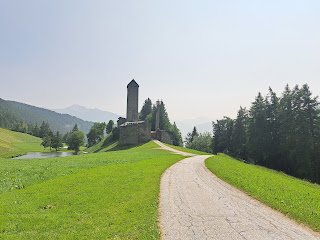Beim Menschen ist es wie beim Velo. Nur wenn er fährt, kann er bequem die Balance halten
(Life is like riding a bicycle. To keep your balance, you must keep moving.)
- Albert Einstein
Hard to get moving again after such a great weekend in the company of so many great people - friends and family! My Dad Ian, husband Silvio and daughter Sara; walking buddies Mariella, Annette and Rossana; and hiking guide friends Daniela and Mauro, who are from Rome but now live mainly in Predazzo, in Trentino, and who so generously hosted us all there over the weekend. Not only that, they fed us great dinners and took us for guided walks in the mountains. We spent a fantastic weekend enjoying the amazing landscapes of the Dolomites and the company of a multicultural, multilingual and multigenerational group that somehow worked perfectly together!
 |
| Walkers... |
 |
| ...and cyclist! |
 |
| All together now |
 |
| Sara |
After a final dinner together, our group reluctantly prepared to split up and go our separate ways. In the Italian part of the Via Romea Germanica, starting from the Brenner Pass, I will be accompanied by my historic walking buddy Mariella. We have walked across France together, and survived some particularly tough routes, such as the Via Aurelia (GR653A) in France and the Via del Volto Santo in Italy. As well as lots of hikes at home in Liguria!
Silvio and Sara drove us to the nearest train station, at Ora (Auer), where we had a final cup of coffee together before taking the train: my Dad, Annette and Rossana to Bolzano, where they switched to a direct Intercity train to Munich, while Mariella and I stayed on the train all the way back up to the Brenner Pass.
 |
| View over Ora in the main valley of Alto Adige/Trentino, down which we will be walking |
Back at the Brenner Pass, we were pleased to discover that the temperature was a few degrees cooler than it had been further down the valley, and the air less hazy. We obtained a stamp for our pilgrim credentials at the tobacconist's shop and set off along the cycling path that follows the route of the former railway line beside the highway, which we followed for ten uneventful kilometres all the way to Colle d'Isarco (Gossensass in German).
 |
| Abandoned railway station |
 |
| Zigzagging down the hill into Colle d'Isarco |
 |
| Leaving Colle d'Isarco behind |
After picnicking on a bench beside a very pretty cemetery with wrought iron crosses, we carried on through Colle d'Isarco and then climbed up a steep slope, passing under the motorway bridge and then climbing some more, across the Alpine meadows, past a waterfall and the ruins of Strassberg castle, then into a beautiful forest of conifers.
When we emerged from the woods, the town of Sterzing or Vipiteno was in sight, and soon we had crossed under the railway tracks and into the town.
Vipiteno
In the year 14 B.C. Nero Claudius Drusus founded "Vipitenum", a military camp on the road between present-day Germany and Italy. Ancient ruins found in the area include a sepulchral monument dedicated to Postumia Vittorina, a milestone dating back to the time of Emperor Septimius Severus, and a stone altar dedicated to Lord Mithras. The first mention of a town called Wibitina dates back to the years between 985 and 990; the same name appears in the current name of the valley, Wipptal, and in the name of the nearby Celto-Roman settlement Vibidina. The Germanic name Sterçengum, now Sterzing, first appears in a document dated 1182.
Sterzing had its golden age in the 15th and 16th centuries, after the fire of 1443 which destroyed much of the town. New embattled houses were built, some in late gothic style, in the area referred to as Neustadt (New Town), as the community prospered thanks to the mining industry. Most of the mines were owned by the Fuggers, the wealthiest family in Europe around the year 1500, as described in my blog entry on Biberbach, the day before Augsburg.
The city's most famous landmark is the Zwölferturm, a 46 metre high tower erected in 1470, symbol of the city marking the division between Neustadt and Altstadt: the New Town and the Old Town. A fire in 1867 destroyed the original spire of the tower, which was replaced with the present embattled roof.
We wandered about the Old Town and the New Town (new only in relative terms, as it was built after the fire of 1443), peering into the churches and contemplating which bar to stop at for beer and a bite to eat. We eventually settled on a pizza place in the New Town, with a gelateria handily located right across the street for dessert. As we were finishing our meal I got a phone call from the local priest, saying he was back in town and we could come on over to the parish centre. Don Giorgio lives in a large parish complex which includes not only his apartment but several meeting rooms, a food bank and a 12-bed hostel in the attic, which is available for pilgrims on the Via Romea Germanica when it's not being used by Scouts or other groups. Luckily for us, the hostel is available today, and Don Giorgio even said we could come back by bus or train and stay another night at the end of tomorrow's stage, as we have been unable to find any affordable accommodation there.
An excellent start to the Italian part of the Via Romea Germanica!
 |
| Oratorio Maria Schutz, the parish centre |
 |
| My corner of our attic room |
Brennerpass - Vipiteno/Sterzing 18 km































No comments:
Post a Comment